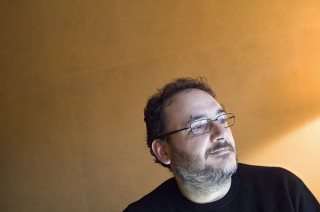|
Back
The Personality of Passion New York
Isaac Stern Auditorium, Carnegie Hall
02/21/2017 -
Claudio Monteverdi: L’incoronazione di Poppea
Miah Persson (Fortuna, Poppea), Leonardo Cortellazzi (Nerone), Roberta Invernizzi (Ottavia),
Sara Mingardo (Ottone), Salvo Vitale (Seneca, Tribuno 1), Francesca Cassinari (Virtù, Valletto),
Aurelio Schiavoni (Arnalta, Familiare 1), Monica Piccinini (Drusilla), Anna Simboli (Amore, Damigella), Valerio Contaldo (Soldato 1, Familiare 2, Lucano, Console 1), Raffaele Giordani (Soldato 2, Nutrice, Console 2), Mauro Borgioni (Mercurio, Familiare 3, Tribuno 2, Liberto)
Concerto Italiano, Rinaldo Alessandrini (Conductor and harpsichord)

R. Alessandrini (© Eric Larrayadieu/Naïve)
“I now keep well from the Greek method of words and signs. They are only harmonic. Instead, for the benefit of good art, I am employing voices and characters.”
Claudio Monteverdi, 1634 (from The Letters of Claudio Monteverdi, translated and introduced by Denis Stephens)
Last night’s performance of Monteverdi by Concerto Italiano was for the purists. Jordi Savall’s opening for Carnegie Hall’s “La Serenissima” was a program of fireworks: a huge Renaissance orchestra, a thesaurus of Venetian musical history, and one Monteverdi 20-minute opera fit amongst the other music. On Saturday, Cappella Mediterranea presented an evening of Monteverdi, which was like “The Best Of...” Series, some of the most astonishing arias, madrigals and excerpts from two operas.
But last night, Rinaldo Alessandrini and his Concerto Italiano presented The Coronation of Poppea not only in its entirety, but with few allowances to its audience. Though a few caveats must be mentioned.
Nobody knows exactly how much the ailing 75-year-old composer actually wrote, and nobody knows how large the orchestra was, or which arias were actually included. Two different scores have been found, each incomplete. And while musicologists have easily made “working copies” of the opera, authenticity can never be guaranteed.
I had brought my own copy of the score, Raymond Leppard’s elaborate re-writing, but that was useless. Instead, the conductor offered what might have been as pure a production as possible on the massive Carnegie Hall state.
Although Maestro Alessandrini did make the best of it. While I feel that, for such an unusual story, for his final opera, Monteverdi might have used a larger orchestra, the conductor gave almost a skeleton consort. A string quartet, a bass, two theorbos, a harp and two harpsichords was the background music. So no, this wasn’t Berlioz! But the background served its purpose.
Perhaps, in fact, this opera might have been more personal, more intimate on the Zankel Hall stage. Orfeo has the grandiosity of Issac Stern auditorium. Poppea has a story which could have been in a television soap–misplaced lovers, husbands deceived, badly attempted murder-revenge (unfilled thanks to a deus ex machina, in this case Amore). But no chorus appears, no fanfares. This was intimacy for an intimate stage.
And since Monteverdi probably didn’t write his own orchestral interludes, the Concerto Italiano leader/founder wrote many of his own. Even eliminating the most popular opening overture for a probably original composition.
As a concert version, those looking for 17th Century theatrics would have been disappointed. In appropriate modern garb (police uniforms for the guards, tie and jacket for Nero), the singers came and left on the stage. They sung their songs, interacted with their partners, and left.
In that sense, this Poppea–at least Act I with its expositions–put a few audience members off, and they left in the intermission. Yet they did see perhaps the most stunning pair of scenes in the whole operatic repertory. The sultry, emotional–oh, hell, the sexy–love duet between Poppea and Nero. Throbbing strings, harp runs, and the two lovers living it up with the greatest passion.
The second was the death of Seneca. And now we come to the wondrous ensemble of singers brought in by Mr. Alessandrini. Specifically here Salvo Vitale, a basso profundo for the ages. His monologue here on the pain of living, the joy of death (contrasted with the messengers, who love life, an ironic piece of genius), and his entrance to the end of life, was given with pain, a purity of voice, and finally that sonorous low D.
With the libretto, just about everybody is a rascal, except Seneca. But as played here, with sobriety, eloquence and honesty, he is the least interesting. Except as singer.
That finished the first act (an arbitrary division), and the second act was superior in every way. This had nothing to do with the conductor; the libretto simply gave more room for pure expression.
Where before we had exposition (and some fine duets), here, in this well-crafted opera, we had raucous humor, melodrama, love, triumph and revenge. Nero and his poet friend lurched about in semi-drunken happiness that Seneca was dead. Various nurses and guards gave bad advice and changed to good advice. Various goddesses appeared, did their part and left.
And each scene, with all Monteverdi’s mélange of aria and recitative (it had an almost miraculous likeness to Verdi’s Falstaff) was written with the greatest care by Giovanni Francesco Busenello, while the composer let the words erupt, and the skeleton orchestra allowed us to hear them.
As I said, Mr. Vitale’s Seneca was the great contrast as a bass. Miah Persson was a seductive Poppea, with a luscious soprano. Nero was the tenor hero (such a hero! Peter Ustinov would have been amused), and others in the large cast played their parts well.
Rinaldo Alessandrini has one of the finest period-orchestras in Italy if not Europe, and his choice of ensemble seemed exactly right for this so-period opera. Of course everybody who knows the piece waits for the last duet, but “Pur ti miro” (“I adore thee”) sounds more like the finale to a Sigmund Romberg/Franz Lehár operetta.
Still, what we call schmaltz, those Venetians of 1643 called the height of originality. And if we must suspend our disbelief, both for opera and Venetian 17th Century sensibilities, we can still be thrilled by this cynical, salacious and most human opera.
Harry Rolnick
|